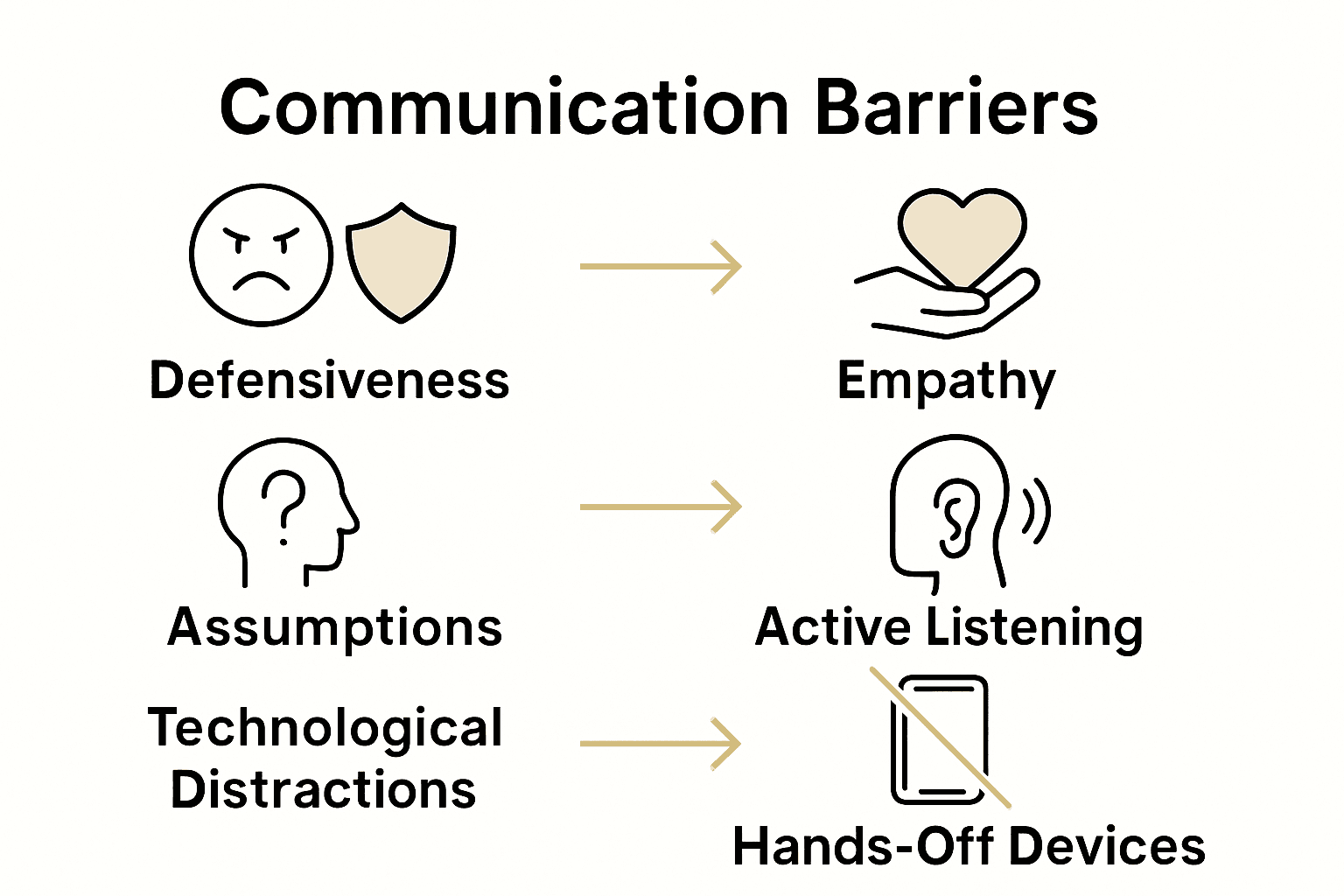
Nearly 90 percent of families report that open, honest communication leads to stronger relationships and a happier home. The way families interact each day shapes trust, well-being, and emotional health for everyone under one roof. When households prioritize healthy conversations, they create foundations that support growth, resolve conflict, and keep connections strong, even during stressful times.
Table of Contents
- Defining Family Communication And Its Importance
- Common Types Of Family Communication Styles
- Essential Strategies For Effective Interaction
- Overcoming Communication Barriers At Home
- Building Lasting Harmony Through Daily Routines
Key Takeaways
| Point | Details |
|---|---|
| Importance of Family Communication | Effective family communication fosters understanding, trust, and emotional support, significantly impacting the well-being of family members, especially adolescents. |
| Communication Styles | Families develop unique communication styles that influence dynamics and emotional well-being, necessitating awareness and adaptability to enhance relationships. |
| Strategies for Effective Interactions | Intentional methods such as active listening and emotional validation are essential for successful family communication, requiring flexibility and a commitment to understanding one another. |
| Overcoming Barriers | Addressing communication barriers with patience and empathy transforms conflicts into opportunities for deeper connections, promoting a collaborative approach to family interactions. |
Defining Family Communication and Its Importance
Communication isn’t just about talking - it’s about connecting. Family communication represents the intricate web of verbal and nonverbal interactions that bind households together, creating understanding, trust, and emotional support. At its core, effective family communication transforms ordinary conversations into meaningful exchanges that nurture relationships and individual growth.
Research from pubmed.ncbi.nlm.nih.gov highlights the profound impact of communication patterns on family dynamics, particularly for adolescents. The study reveals that communication styles directly influence family members’ well-being, demonstrating how the quality of interactions can shape emotional development and interpersonal relationships. Key aspects of strong family communication include:
- Active listening
- Expressing feelings openly
- Practicing empathy
- Maintaining respectful dialogue
- Creating safe spaces for sharing
Further insights from journals.kmanpub.com underscore the critical role of communication in academic and personal success. When families establish healthy communication patterns, they create supportive environments that enable members to navigate challenges, share experiences, and grow together. This isn’t about perfection - it’s about consistent, genuine effort to understand and support one another.
Building strong family communication requires intentionality. It means setting aside distractions, being present, and valuing each interaction as an opportunity to strengthen connections. Whether discussing daily experiences, resolving conflicts, or sharing dreams, every conversation is a chance to reinforce the fundamental bonds that make a family resilient and supportive.
Common Types of Family Communication Styles
Understanding family communication styles is crucial for building healthier, more supportive household dynamics. These communication patterns represent distinctive ways families interact, share information, and resolve conflicts. Just like fingerprints, each family develops its unique communication approach that significantly influences relationships and emotional well-being.
Research from he02.tci-thaijo.org reveals fascinating insights into communication patterns, identifying several primary styles families typically adopt. These communication styles can be broadly categorized into four primary approaches:
- Consensual Communication Style: Open, collaborative interactions where family members freely express opinions
- Protective Communication Style: More reserved interactions with limited emotional sharing
- Pluralistic Communication Style: Encouraging individual perspectives while maintaining family cohesion
- Laissez-Faire Communication Style: Minimal structured communication with high personal autonomy
Further insights from journal.ipb.ac.id highlight how communication patterns profoundly impact adolescents’ personal and social identity development. The research underscores that communication styles are not static but evolve with family dynamics, individual growth, and changing life circumstances.
Recognizing and understanding these communication styles empowers families to intentionally adapt their interactions. By becoming aware of inherent communication patterns, families can develop more empathetic, transparent, and supportive relationships.
 The goal isn’t to achieve a perfect communication style but to create an environment where every family member feels heard, respected, and valued.
The goal isn’t to achieve a perfect communication style but to create an environment where every family member feels heard, respected, and valued.
Essential Strategies for Effective Interaction
Successful family communication isn’t about perfection - it’s about intentional connection. Creating meaningful interactions requires a deliberate approach that goes beyond casual conversations, focusing on building trust, understanding, and emotional support within the household.
Research from academic.oup.com highlights key standards that distinguish high-quality family communication. These strategies transform ordinary exchanges into powerful moments of genuine connection. Practical approaches include:
- Practice active and empathetic listening
- Create judgment-free dialogue spaces
- Validate each family member’s emotions
- Use “I” statements to express feelings
- Demonstrate consistent emotional availability
- Respect individual communication preferences
The study from ijrte.org emphasizes that effective communication isn’t a one-size-fits-all model. Each family member brings unique communication styles and emotional needs, requiring flexibility and mutual understanding.
Successful interactions demand continuous learning and adaptive approaches.
Ultimately, effective family communication is a skill that improves with practice. It requires patience, vulnerability, and a genuine commitment to understanding one another. By prioritizing honest, respectful dialogue, families can create resilient bonds that withstand life’s inevitable challenges and transformations.
Overcoming Communication Barriers at Home
Communication barriers can transform family interactions from supportive connections into frustrating encounters. Effective communication requires recognizing and actively addressing these obstacles that prevent genuine understanding and emotional connection within households.
Research from pubmed.ncbi.nlm.nih.gov reveals critical insights into family communication dynamics, highlighting how different communication approaches directly impact family relationships. The study emphasizes that overcoming barriers isn’t about eliminating disagreements, but developing strategies to navigate them constructively. Common communication barriers include:
- Emotional defensiveness
- Assumptions and mind-reading
- Unresolved past conflicts
- Generational communication differences
- Lack of active listening
- Technological distractions
Further insights from wjarr.com demonstrate that successful families develop cognitive flexibility - the ability to adapt communication strategies based on individual needs and changing circumstances. This approach involves understanding that each family member processes information and emotions differently, requiring patience and empathy.
Breaking down communication barriers demands intentional effort from every family member. It means creating safe spaces for honest dialogue, practicing emotional vulnerability, and committing to understanding rather than winning arguments. By approaching communication as a collaborative journey of mutual respect and learning, families can transform potential conflicts into opportunities for deeper connection and understanding.

Building Lasting Harmony Through Daily Routines
Family harmony isn’t about grand gestures - it’s about consistent, intentional interactions woven into everyday life. Daily routines serve as the invisible threads that bind families together, transforming mundane moments into opportunities for connection, understanding, and mutual support.
Research from link.springer.com highlights the profound impact of structured daily routines on family dynamics. The study reveals that families who establish predictable, shared experiences create a sense of security and emotional stability. Key routines that foster family harmony include:
- Shared meals without digital distractions
- Morning check-in conversations
- Evening reflection time
- Collaborative household chores
- Weekly family planning meetings
- Consistent bedtime rituals
Additional insights from arxiv.org emphasize that successful interaction styles emerge from deliberate, repeated practices. These routines aren’t about perfection but about creating predictable spaces where family members feel heard, valued, and connected. When practiced consistently, these interactions build emotional resilience and strengthen familial bonds.
Building lasting harmony requires commitment from every family member. It means showing up daily, being present, and valuing connection over convenience. Learn more about organizing your home environment to support these meaningful interactions. By transforming routine moments into opportunities for genuine connection, families can create a supportive ecosystem that nurtures individual growth and collective well-being.
Strengthen Family Communication with an Organized Home Environment
The article highlights how effective family communication thrives in safe, distraction-free spaces where every member feels heard and valued. Yet daily distractions and clutter often become silent barriers to genuine connection. Creating intentional, organized routines at home supports emotional availability and peaceful dialogue. By transforming your living spaces with smart storage solutions, you lay the foundation for clearer, calmer conversations and lasting family harmony.

Discover how thoughtfully designed storage boxes, baskets, and dividers at BlushBees can help you reclaim your family’s shared spaces from chaos. Start building predictable, organized routines that encourage open communication and reduce tension today. Explore practical home organization ideas and stylish storage options at BlushBees to create an environment where your family’s connections can truly flourish.
Frequently Asked Questions
What are effective family communication strategies?
Effective family communication strategies include active listening, creating judgment-free spaces for dialogue, validating emotions, using “I” statements to express feelings, and demonstrating emotional availability.
How can families overcome communication barriers?
Families can overcome communication barriers by recognizing emotional defensiveness, avoiding mind-reading assumptions, addressing unresolved past conflicts, and committing to active listening while minimizing technological distractions during conversations.
What are the common types of family communication styles?
The common types of family communication styles include consensual (open, collaborative), protective (reserved), pluralistic (encouraging individual perspectives), and laissez-faire (minimal structure with high autonomy).
Why is daily routine important for family communication?
Daily routines are important for family communication because they create consistent opportunities for family members to connect, share experiences, and support one another, ultimately strengthening familial bonds and emotional resilience.
Recommended
- Family Organization Systems: Complete Guide for Homes – BLUSHBEES USA
- Family Organization Calendar: Complete Guide for Homes – BLUSHBEES USA
- Where to Start When Your Whole House is a Mess: Expert Tips – BLUSHBEES USA
- Understanding Essential Tips for Busy Moms – BLUSHBEES USA
- How to Structure Family Governance for Lasting Impact - Future Family Office



